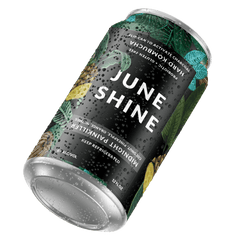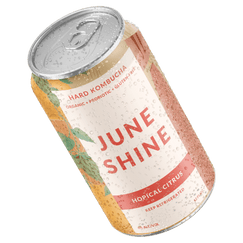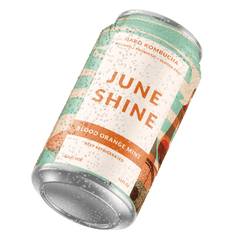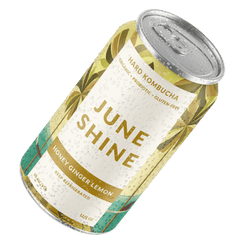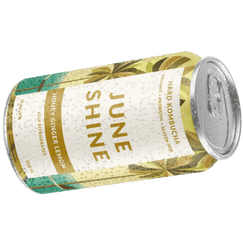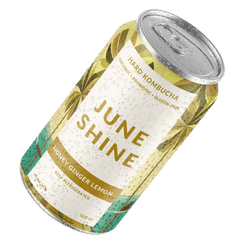The History of Nutmeg

Here at JuneShine, we love nutmeg for the rich flavor and perfect zest it adds to our Midnight Painkiller. We decided to dig into the rich history of this spice that sends your tastebuds straight to a winter wonderland (or a tropical paradise). Crack a can and read on.
What Is Nutmeg?
Seriously though. Does anyone really know?
You can enjoy either whole or ground nutmeg. It’s known for its rich, warm, nutty flavor, a popular addition to sweet and savory dishes. Think pumpkin pie, fall harvest sausages, stirred into a bechamel sauce over pasta… We’ll stop. We personally like nutmeg for the little flavor kick it gives to painkiller cocktails, so we added it to our version.
The name “nutmeg” is a bit misleading. Nutmeg is actually a seed, not a tree nut. If you have a peanut or tree nut allergy, fear not.
The spice that we refer to as nutmeg is made from the inner portion of the seed inside the plant’s fruit. It comes from the nutmeg tree, a type of evergreen native to the Banda Islands, also known as the Spice Islands of Indonesia.
Not to be confused with the spice mace, which comes from the same tree, nutmeg is the seed found inside the apricot-sized fruit, while the lacy membrane engulfing the seed is mace. The brownish seed has an ovular shape with a wrinkled surface and is considered a drupe.
When the fruit fully matures, it splits in two. Inside, you’ll find the aril, the mace, and the coveted nutmeg seed. The inner nutmeg seeds are dried for six to eight weeks and turned twice daily before being converted into a powder or sold whole.
Nutmeg Oils
Nutmeg has more uses than just adding flavor to drinks and pies. Nutmeg is also used for its essential oils. Together with mace, the seed is anywhere from seven to 14 percent essential oil, including pinene, camphene, and diplotene.
The oil derived from the nut is thought to soothe joint pain, elevate mood, and even treat the symptoms of colds. Plus, thanks to its delicious scent, it’s often found in perfumes, soaps, moisturizers, and other dental and healthcare products.
Nutmeg also yields an oil known as nutmeg butter. This creamy yellow butter is semi-solid and is used in many balms and beauty products as well.
Nutmeg’s Long History
Getting your nutmeg fix back in the day wasn’t as easy as hopping on this here website and clicking “order” or hitting up one of our partners. In fact, the history of nutmeg is a long and mysterious one with some not-so-hot events. People really loved nutmeg and would stop at nothing to get a taste.
The origins of the seed date back to the Romans. Around the first century, A.D, Roman author Pliny wrote of a tree that bore nuts with two flavors—likely mace and nutmeg.
Both Roman examples of nutmeg use are a little shaky, but it’s agreed that nutmeg was used in the Middle Ages. During that time, nutmeg was a prized spice mostly used in medicine and as a preserving agent. Wealthy noblemen and women used nutmeg graters to grind up the spice and added it to alcoholic drinks to show off just how much they were raking in.
Nutmeg Becomes a World Traveler
The popularity of the spice rose during the Crusades when Europeans encountered Middle Eastern culture. Venetian spice traders ensured that its popularity rose over the next few centuries.
In the sixth century, Emperor Henry VI reportedly fumigated the streets of Rome with nutmeg before his coronation to create a sweet-smelling environment. The sweet smell of nutmeg was one of the reasons for its popularity. It was used to cover up sour smells of foods that were going bad or, in Henry’s case, the dirty streets of the Roman metropolis.
During the Spice Trade, also in the sixth century, nutmeg was brought by Arab merchants to Constantinople. They kept the origins secret and quantities low in order to raise prices.
As with most expensive foreign goods, the elite became obsessed, and the spice became even more popular in Europe. At one point, the price of one pound of nutmeg equaled that of “seven fat oxen” in Germany, while in England, a few nutmeg nuts could be sold for enough money to enable financial independence for life.
In the Elizabethan era, nutmeg was thought to ward off diseases and plague, so it became a commodity yet again. This time, however, nutmeg was scarce due to the Turks closing the trade routes from Asia to Europe.
The Portuguese Get Involved in the Nutmeg Trade
Around the same time in the 15th century, the Banda Islands where the seed was harvested were facing impending doom from invaders. Portuguese explorers were sent on an expedition in 1512 by commander Albuquerque of the Portuguese fleet stationed in Malacca, Malaysia, to get the spice denied to them by the Turks.
The fleet’s mission was to locate the so-called “spice islands” of lore. Locate they did, and the commander of the boats, Francisco Serrao, became the first European to gather nutmeg and cloves from the archipelago.
At this point, the Portuguese gained control of the islands. Their reign made nutmeg more affordable and available in Europe. At least until the Dutch ousted them in the early 17th century…
In Comes the Dutch East India Company
The Dutch East India Trading Company was a megacorporation with its sights set on gaining control of the Philippines. So, they did what countries do when they want something: they had a civil discussion and agreed to work together to create a better world. Which, of course, is slang for started a massive, brutal war.
The Dutch began massacring and enslaving many of the Banda natives in 1621. They made expeditions onto the islands to excavate trees and plant them elsewhere, but the islands remained home to the largest supply of the precious seeds. The Dutch ruled with an iron fist, destroying plantations and creating strict laws that were enforced by the death penalty.
Maybe the craziest move the Dutch made to preserve this area was a trade with the British in 1667. The Treaty of Breda was a result of the ongoing wars between the Dutch and English for control of overseas colonies and trade.
The treaty between the Dutch and the English, amongst other things, handed over control of New Amsterdam (aka New York City) to the British in order for the Dutch to remain in control over Run Island, the only Banda Island that produced nutmeg at the time.
Smuggling Nutmeg
The Dutch held control of the islands for another hundred years or so. Unfortunately for them, during a period of Dutch lapse in control of the islands during the Napoleonic Wars, French spice traders successfully smuggled nutmeg trees out of Banda and over to Zanzibar and Grenada. The latter’s flag now bears a nutmeg seed.
Thus began the downfall of the Dutch nutmeg monopoly. Nutmeg trees spread to other countries, and pretty soon, a studio apartment in Manhattan was worth more than the land the Dutch traded to keep.
Nutmeg Today
These days, the average world production of nutmeg is around 10-12 thousand metric tons per year. It’s a favorite in spice blends alongside ginger and cardamom and in dishes that complement vegetables like sweet potatoes and spinach. The demand averages around 9 thousand metric tons.
Indonesia remains one of the top producers with over 75% of the world nutmeg market share, while Grenada has earned its flag by producing around 20%. In Connecticut, the state nickname “The Nutmeg State” was applied due to early inhabitants who allegedly sold wooden nutmegs to unknowing buyers.
If you secure yourself some non-wooden nutmeg, think of all the ways you can enjoy it; as a delicious garnish on cakes, custards, and pies, as an alternative to cinnamon on top of a glass of eggnog, or even mixed into a savory dish with chicken and cheese.
There’s a reason Midnight Painkiller is one of our most popular flavors. Does nutmeg have something to do with that? There’s only one way to find out…
Sources:
What Is Nutmeg? Learn How to Cook With Nutmeg - 2021 | MasterClass
Nutmeg News - Nutmeg Reports - Crop Production 2021 - Market Price | Spicefactors.com.
Connecticut's Nicknames | Connecticut State Library
Martha's Vineyard News | Nutmeg Love
The Blood-Soaked History of Nutmeg | Owlcation
Treaty of Breda, 1667 | NYCourts.gov
Nutmeg - Kitchen Dictionary | Food.com
Medicinal Spices Exhibit | Ucla.edu
Nutmeg News - Nutmeg Reports - Crop Production 2021 - Market Price | Spice factors.
